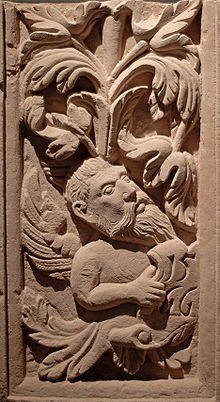Caspar Vischer (architect)
Caspar Vischer , also Caspar Fischer (* probably 1510 in Kulmbach ; † August 11, 1579 there ) was a German architect of the Renaissance .

Life
For the first time he appeared according to the Bayreuth chamber bill of 1542: " Fl maister Caspar Steinmetz von Culmbach to announce that Inn has been accepted by the Statmeister and has not moved ". He did not accept this position, probably to accept the job as a stonemason for the construction of Rosenau Castle , which he completed in 1547. In 1548 he worked as the second electoral builder on the Ottheinrichsbau of Heidelberg Castle . On July 1, 1561, Margrave Georg Friedrich von Ansbach -Kulmbach commissioned him to rebuild Plassenburg , which had been destroyed in the Federal War . Caspar Vischer remained in the position of Supreme Master Builder until his death, when the Plassenburg was not yet completed. From 1573 he built the armory and the fortifications. His architectural style was significantly inspired by his teacher Paul Beheim .
One of his outstanding achievements is the design of the beautiful courtyard of the Plassenburg with more than 120 relief chest images in medallion form, which was probably made between 1565 and 1570. These pictures represent the ancestors of the Hohenzollern family up to Albrecht Alcibiades and decorate one of the most harmonious arcaded courtyards of the Renaissance.
Other achievements of Caspar Vischer included:
- The castle Streitberg (1563 to 1565)
- The Neue Rathsstube ( old court ) and the magnificent gate in Bamberg (1569)
- The former official palace in Pegnitz -Altenstadt (1571 to 1573)
- The Böheimstein Castle near Pegnitz, successor to Böheimstein Castle (1579)
- The margravial chancellery (later the district court building) next to the Petrikirche in Kulmbach (1562 and 1563)
- New construction of the Künßberg Castle in Wernstein (1563 to 1567)
- Reconstruction work on Thurnau Castle (1565)
- Numerous works on Kulmbach town houses and townhouses, including the castle estates
The Kulmbacher Caspar-Vischer-Gymnasium ( CVG ) was named in his honor.
Web links
| personal data | |
|---|---|
| SURNAME | Vischer, Caspar |
| ALTERNATIVE NAMES | Fischer, Caspar |
| BRIEF DESCRIPTION | German architect |
| DATE OF BIRTH | 1510 |
| PLACE OF BIRTH | Kulmbach |
| DATE OF DEATH | August 11, 1579 |
| Place of death | Kulmbach |
